RMS Olympic
 RMS Olympic on her sea trials in Belfast in 1911 | |
| History | |
|---|---|
| Name: | RMS Olympic |
| Owner: |
|
| Port of registry: | Liverpool, United Kingdom |
| Route: | Southampton to New York City |
| Ordered: | 1907 |
| Builder: | Harland and Wolff, Belfast |
| Cost: | $7.5 million (USD) |
| Yard number: | 400 |
| Laid down: | 16 December 1908 |
| Launched: | 20 October 1910 |
| Completed: | 31 May 1911 |
| Acquired: | 31 May 1911 |
| Maiden voyage: | 14 June 1911 |
| In service: | 1911 |
| Out of service: | 1935 |
| Identification: |
|
| Fate: | Retired at Southampton after 24 years service & scrapped. Superstructure dismantled at Jarrow, England, and the hull at Inverkeithing, Scotland. |
| Status: | Scrapped |
| General characteristics | |
| Class and type: | Olympic-class ocean liner |
| Tonnage: | 45,324 gross register tons; 46,358 after 1913; 46,439 after 1920 |
| Displacement: | 52,067 tons |
| Length: | 882 ft 6 in (269.0 m) |
| Beam: | 92 ft 6 in (28.2 m) |
| Height: | 175 ft (53.3 m) (keel to top of funnels) |
| Draught: | 34 ft 7 in (10.5 m) |
| Decks: | 9 decks (8 for passengers and 1 for crew) |
| Installed power: | 24 double-ended (six furnace) and 5 single-ended (three furnace) Scotch boilers. Two four-cylinder triple-expansion reciprocating engines each producing 15,000 hp for the two outboard wing propellers at 75 revolutions per minute. One low-pressure turbine producing 16,000 h. 59,000 hp produced at maximum revolutions.[1] |
| Propulsion: | Two bronze triple-blade wing propellers. One bronze quadruple-blade centre propeller. |
| Speed: |
|
| Capacity: | 2,435 passengers |
| Crew: | 950 |
| Notes: | First in a trio of Olympic-class ocean liners for White Star Line and the only one to have a successful career. Elder sister to RMS Titanic and HMHS Britannic. |
RMS Olympic (/ʊˈlɪmpɪk/) was a transatlantic ocean liner, the lead ship of the White Star Line's trio of Olympic-class liners. Unlike her younger sister ships, Olympic had a long career, spanning 24 years from 1911 to 1935. This included service as a troopship during the First World War, which gained her the nickname "Old Reliable". Olympic returned to civilian service after the war and served successfully as an ocean liner throughout the 1920s and into the first half of the 1930s, although increased competition, and the slump in trade during the Great Depression after 1930, made her operation increasingly unprofitable.
Olympic was the largest ocean liner in the world for two periods during 1911–13, interrupted only by the brief tenure of the slightly larger Titanic (which had the same dimensions but higher gross tonnage owing to revised interior configurations), before she was then surpassed by SS Imperator. Olympic also retained the title of the largest British-built liner until the RMS Queen Mary was launched in 1934, interrupted only by the short careers of her slightly larger sister ships.[2][3]
By contrast with Olympic, the other ships in the class, Titanic and Britannic, did not have long service lives. On the night of 14/15 April 1912, Titanic collided with an iceberg in the North Atlantic and sank, claiming more than 1,500 lives; Britannic struck a mine and sank in the Kea Channel (Greece) in the Mediterranean on 21 November 1916, killing 30 people.
Background
Built in Belfast, Ireland, the RMS Olympic was the first of the three Olympic-class ocean liners – the others were the RMS Titanic and the HMHS Britannic.[4] They were by far the largest vessels of the British shipping company White Star Line's fleet, which comprised 29 steamers and tenders in 1912.[5] The three ships had their genesis in a discussion in mid-1907 between the White Star Line's chairman, J. Bruce Ismay, and the American financier J. Pierpont Morgan, who controlled the White Star Line's parent corporation, the International Mercantile Marine Co. The White Star Line faced a growing challenge from its main rivals Cunard, which had just launched Lusitania and Mauretania – the fastest passenger ships then in service – and the German lines Hamburg America and Norddeutscher Lloyd. Ismay preferred to compete on size and economics rather than speed and proposed to commission a new class of liners that would be bigger than anything that had gone before as well as being the last word in comfort and luxury.[6] The company sought an upgrade in their fleet primarily in response to the Cunard giants but also to replace their largest and now outclassed ships from 1890, the SS Teutonic and SS Majestic. The former was replaced by Olympic while Majestic was replaced by Titanic. Majestic would be brought back into her old spot on White Star's New York service after Titanic's loss.
The ships were constructed by the Belfast shipbuilders Harland and Wolff, who had a long established relationship with the White Star Line dating back to 1867.[7] Harland and Wolff were given a great deal of latitude in designing ships for the White Star Line; the usual approach was for the latter to sketch out a general concept which the former would take away and turn into a ship design. Cost considerations were relatively low on the agenda and Harland and Wolff was authorised to spend what it needed on the ships, plus a five percent profit margin.[7] In the case of the Olympic-class ships, a cost of £3 million for the first two ships was agreed plus "extras to contract" and the usual five percent fee.[8]
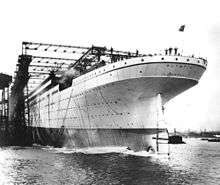
Harland and Wolff put their leading designers to work designing the Olympic-class vessels. It was overseen by Lord Pirrie, a director of both Harland and Wolff and the White Star Line; naval architect Thomas Andrews, the managing director of Harland and Wolff's design department; Edward Wilding, Andrews' deputy and responsible for calculating the ship's design, stability and trim; and Alexander Carlisle, the shipyard's chief draughtsman and general manager.[9] Carlisle's responsibilities included the decorations, equipment and all general arrangements, including the implementation of an efficient lifeboat davit design.[10]
On 29 July 1908, Harland and Wolff presented the drawings to J. Bruce Ismay and other White Star Line executives. Ismay approved the design and signed three "letters of agreement" two days later authorising the start of construction.[11] At this point the first ship – which was later to become Olympic – had no name, but was referred to simply as "Number 400", as it was Harland and Wolff's four hundredth hull. Titanic was based on a revised version of the same design and was given the number 401.[12] Bruce Ismay's father Thomas Henry Ismay had previously planned to build a ship named Olympic as a sister ship to the Oceanic. The senior Ismay died in 1899 and the order for the ship was cancelled.[13]
Construction of Olympic began three months before Titanic to ease pressures on the shipyard. Several years would pass before Britannic would be launched. In order to accommodate the construction of the class, Harland and Wolff upgraded their facility in Belfast; the most dramatic change was the combining of three slipways into two larger ones. Olympic's keel was laid in December 1908 and she was launched on 20 October 1910.[4] For her launch, the hull was painted in a light grey colour for photographic purposes; a common practice of the day for the first ship in a new class, as it made the lines of the ship clearer in the black and white photographs. Her hull was repainted black following the launch.[3]
Features

The Olympic was designed as a luxury ship; her passenger facilities, fittings, deck plans and technical facilities were largely identical to those of her more famous sister Titanic, although with some small variations.[14] The first-class passengers enjoyed luxurious cabins, and some were equipped with private bathrooms. First-class passengers could have meals in the ship's large and luxurious dining room or in the more intimate A La Carte Restaurant. There was a lavish Grand Staircase, built only for the Olympic-class ships, along with three lifts that ran behind the staircase down to E deck,[15] a Georgian-style smoking room, a Veranda Café decorated with palm trees,[16] a swimming pool, Turkish bath,[17] gymnasium,[18] and several other places for meals and entertainment.
The second-class facilities included a smoking room, a library, a spacious dining room, and a lift.[3][19]
Finally, the third-class passengers enjoyed reasonable accommodation compared to other ships, if not up to the second and first classes. Instead of large dormitories offered by most ships of the time, the third-class passengers of the Olympic travelled in cabins containing two to ten bunks. Facilities for the third class included a smoking room, a common area, and a dining room.[3][19]
Olympic had a cleaner, sleeker look than other ships of the day: rather than fitting her with bulky exterior air vents, Harland and Wolff used smaller air vents with electric fans, with a "dummy" fourth funnel used for additional ventilation. For the power plant Harland and Wolff employed a combination of reciprocating engines with a centre low-pressure turbine, as opposed to the steam turbines used on Cunard's Lusitania and Mauretania.[20] White Star had successfully tested this engine set up on an earlier liner SS Laurentic, where it was found to be more economical than expansion engines or turbines alone. Olympic consumed 650 tons of coal per 24 hours with an average speed of 21.7 knots on her maiden voyage, compared to 1000 tons of coal per 24 hours for both the Lusitania and Mauretania.[21]
Although Olympic and Titanic were nearly identical, and were based on the same design, a few alterations were made to Titanic (and later on Britannic) based on experience gained from Olympic's first year in service. The most noticeable of these was that the forward half of Titanic's A Deck promenade was enclosed by a steel screen with sliding windows, to provide additional shelter, whereas the Olympic's promenade deck remained open along its whole length. Also the promenades on Titanic's B Deck were reduced in size, and the space used for additional cabins and public rooms, including two luxury suites with private promenades. A number of other variations existed between the two ships layouts and fittings. These differences meant that Titanic had a slightly higher gross tonnage of 46,328 tons, compared to Olympic's 45,324 tons.[22]
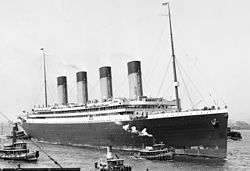
Career
Following completion, Olympic started her sea trials on 29 May 1911, which she successfully completed; Olympic then left Belfast bound for Liverpool, her port of registration, on 31 May 1911. As a publicity stunt the White Star Line timed the start of this first voyage to coincide with the launch of Titanic. After spending a day in Liverpool, open to the public, Olympic sailed to Southampton, where she arrived on 3 June, to be made ready for her maiden voyage.[23] The deep-water dock at Southampton, then known as the "White Star Dock" had been specially constructed to accommodate the new Olympic-class liners, and had opened in 1911.[24]
Her maiden voyage commenced on 14 June 1911 from Southampton, calling at Cherbourg and Queenstown, reaching New York City on 21 June.[25] The maiden voyage was captained by Edward Smith who would lose his life the following year in the Titanic disaster.[26] Designer Thomas Andrews was present for the passage to New York and return, along with a number of engineers, as part of Harland and Wolff's "Guarantee Group" to spot any problems or areas for improvement. Andrews would also lose his life in the Titanic disaster.[27]
As the largest ship in the world, and the first in a new class of superliners, Olympic's maiden voyage attracted considerable worldwide attention from the press and public. Following her arrival in New York, Olympic was opened up to the public and received over 8,000 visitors. More than 10,000 spectators watched her depart from New York harbour, for her first return trip.[28]
Hawke collision
Olympic's first major mishap occurred on her fifth voyage on 20 September 1911, when she collided with the British cruiser HMS Hawke off the Isle of Wight. The collision took place as Olympic and Hawke were running parallel to each other through the Solent. As Olympic turned to starboard, the wide radius of her turn took the commander of the Hawke by surprise, and he was unable to take sufficient avoiding action.[29] Hawke's bow, which had been designed to sink ships by ramming them, collided with Olympic's starboard side near the stern, tearing two large holes in Olympic's hull, above and below the waterline, resulting in the flooding of two of her watertight compartments and a twisted propeller shaft. HMS Hawke suffered severe damage to her bow and nearly capsized. Despite this, Olympic was able to return to Southampton under her own power, and no one was seriously injured or killed.[14][30] Hawke was repaired, but sunk by the German U-boat SM U-9 in October 1914.
Captain Edward Smith was still in command of Olympic at the time of the incident. Two crew members, stewardess Violet Jessop and stoker Arthur John Priest,[31] survived not only the collision with the Hawke but also the later sinking of Titanic and the 1916 sinking of Britannic, the third ship of the class.[32]
At the subsequent inquiry the Royal Navy blamed Olympic for the incident, alleging that her large displacement generated a suction that pulled Hawke into her side.[33][34] The Hawke incident was a financial disaster for Olympic's operator. A legal argument ensued which decided that the blame for the incident lay with Olympic, and although the ship was technically under the control of the pilot, the White Star Line was faced with large legal bills and the cost of repairing the ship, and keeping her out of revenue service made matters worse.[29] However, the fact that Olympic endured such a serious collision and stayed afloat, appeared to vindicate the design of the Olympic-class liners and reinforced their "unsinkable" reputation.[29]

It took two weeks for the damage to Olympic to be patched up sufficiently to allow her to return to Belfast for permanent repairs, which took just over six weeks to complete. To speed up the repairs, Harland and Wolff was forced to delay Titanic's completion in order to use her propeller shaft for Olympic. By 29 November she was back in service, however in February 1912, Olympic suffered another setback when she lost a propeller blade on an eastbound voyage from New York, and once again returned to her builder for repairs. To get her back to service as soon as possible, Harland & Wolff again had to pull resources from Titanic, delaying her maiden voyage from 20 March 1912 to 10 April 1912.[35]
Titanic disaster
On 14 April 1912, Olympic, now under the command of Herbert James Haddock, was on a return trip from New York. Wireless operator Ernest James Moore[36] received the distress call from Titanic, when she was approximately 500 nautical miles (930 km; 580 mi) west by south of Titanic's location.[37] Haddock calculated a new course, ordered the ship's engines to be set to full power and headed to assist in the rescue.[38]
When Olympic was about 100 nautical miles (190 km; 120 mi) away from Titanic's last known position, she received a message from Captain Rostron of Cunard Line's RMS Carpathia, which had arrived at the scene. Rostron explained that Olympic continuing on course to Titanic would gain nothing, as "All boats accounted for. About 675 souls saved [...] Titanic foundered about 2:20 am."[37] Rostron requested that the message be forwarded to White Star and Cunard. He said that he was returning to harbour in New York.[37] Subsequently, the wireless room aboard the Olympic operated as a clearing room for radio messages.[37]
When Olympic offered to take on the survivors, she was heatedly turned down by Rostron, who was concerned that it would cause panic amongst the survivors of the disaster to see a virtual mirror-image of the Titanic appear and ask them to board. Olympic then resumed her voyage to Southampton, with all concerts cancelled as a mark of respect, arriving on 21 April.[3]
Over the next few months, Olympic assisted with both the American and British inquiries into the disaster. Deputations from both inquiries inspected Olympic's lifeboats, watertight doors and bulkheads and other equipment which were identical to those on Titanic.[39] Sea tests were performed for the British enquiry in May 1912, to establish how quickly the ship could turn two points at various speeds, to approximate how long it would have taken the Titanic to turn when it sighted the iceberg.[40]
1912 "mutiny"
Olympic, like Titanic, did not carry enough lifeboats for everyone on board, and was hurriedly equipped with additional, second-hand collapsible lifeboats following her return to Britain. Toward the end of April 1912, as she was about to sail from Southampton to New York, 284 of the ship's firemen went on strike because of fears that the ship's new collapsible lifeboats were not seaworthy. 100 non-union crew were hastily hired from Southampton as replacements, with more being hired from Liverpool.[41]
The 40 collapsible lifeboats were transferred from troopships and put on Olympic, and many were rotten and could not open. The crewmen instead sent a request to the Southampton manager of the White Star Line that the collapsible boats be replaced by wooden lifeboats; the manager replied that this was impossible and that the collapsible boats had been passed as seaworthy by a Board of Trade inspector. The men were not satisfied and ceased work in protest.[42]
On 25 April a deputation of strikers witnessed a test of four of the collapsible boats. Only one was unseaworthy and they said that they were prepared to recommend the men return to work if it was replaced. However the strikers now objected to the non-union strikebreaker crew which had come on board, and demanded that they be dismissed, which the White Star Line refused. 54 sailors then left the ship, objecting to the non-union crew who they claimed were unqualified and therefore dangerous, and refused to sail with them. This led to the scheduled sailing being cancelled.[41][43]
All 54 sailors were arrested on a charge of mutiny when they went ashore. On 4 May 1912 Portsmouth magistrates found the charges against the mutineers were proven, but discharged them without imprisonment or fine due to the special circumstances of the case.[44] Fearing that public opinion would be on the side of the strikers, the White Star Line let them return to work and the Olympic sailed on 15 May.[40]
Refit
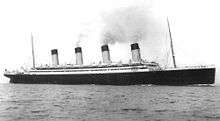
On 9 October 1912 White Star withdrew Olympic from service and returned her to her builders at Belfast to have modifications added to incorporate lessons learned from the Titanic disaster six months prior, and improve safety.[45] The number of lifeboats carried by Olympic was increased from twenty to sixty four (per Carlisle's original number), and extra davits were installed along the boat deck to accommodate them. An inner watertight skin was also constructed in the boiler and engine rooms, to create a double hull. Five of the watertight bulkheads were extended up to B-Deck, extending to the entire height of the hull. This corrected a flaw in the original design, in which the bulkheads only rose up as far as E or D-Deck, a short distance above the waterline. This flaw had been exposed during Titanic's sinking, where water spilled over the top of the bulkheads as the ship sank and flooded subsequent compartments. In addition, an extra bulkhead was added to subdivide the electrical dynamo room, bringing the total number of watertight compartments to seventeen. Improvements were also made to the ship's pumping apparatus. These modifications meant that Olympic could survive a collision similar to that of Titanic, in that her first six compartments could be breached and the ship could remain afloat.[46][47]
At the same time, Olympic's B-Deck underwent a refit, which included extra cabins (the parlour suites which proved popular on the Titanic were added to the Olympic), more cabins were fitted with private bathing facilities, and a Cafe Parisian (another addition that had proved popular on the Titanic) was added, offering another dining option to first class passengers. With these changes, Olympic's gross tonnage rose to 46,359 tons, 31 tons more than Titanic's.[48]
In March 1913, Olympic returned to service and briefly regained the title of largest ocean liner in the world, until the German liner SS Imperator entered passenger service in June 1913. Following her refit, Olympic was marketed as the "new" Olympic and her improved safety features were featured prominently in advertisements. [49][3]
First World War
In August 1914 the First World War began. Olympic initially remained in commercial service under Captain Herbert James Haddock. As a wartime measure, Olympic was painted in a grey colour scheme, portholes were blocked, and lights on deck were turned off to make the ship less visible. The schedule was hastily altered to terminate at Liverpool rather than Southampton, and this was later altered again to Glasgow.[3][50]
The first few wartime voyages were packed with Americans trapped in Europe, eager to return home, although the eastbound journeys carried few passengers. By mid-October, bookings had fallen sharply as the threat from German U-boats became increasingly serious, and White Star Line decided to withdraw Olympic from commercial service. On 21 October 1914, she left New York for Glasgow on her last commercial voyage of the war, though carrying only 153 passengers.[51][50]
Audacious incident
On the sixth day of her voyage, 27 October, as Olympic passed near Lough Swilly off the north coast of Ireland, she received distress signals from the battleship HMS Audacious, which had struck a mine off Tory Island and was taking on water.[52]
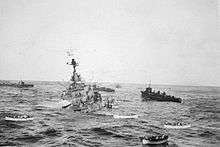
Olympic took off 250 of Audacious's crew, then the destroyer HMS Fury managed to attach a tow cable between Audacious and Olympic and they headed west for Lough Swilly. However, the cable parted after Audacious's steering gear failed. A second attempt was made to tow the warship, but the cable became tangled in HMS Liverpool's propellers and was severed. A third attempt was tried but also failed when the cable gave way. By 17:00 the Audacious's quarterdeck was awash and it was decided to evacuate the remaining crew members to Olympic and Liverpool, and at 20:55 there was an explosion aboard the Audacious and she sank.[53]
Admiral Sir John Jellicoe, Commander of the Home Fleet, was anxious to suppress the news of the sinking of Audacious, for fear of the demoralising effect it could have on the British public, so ordered Olympic to be held in custody at Lough Swilly. No communications were permitted and passengers were not allowed to leave the ship. The only people departing her were the crew of Audacious and Chief Surgeon John Beaumont, who was transferring to RMS Celtic. Steel tycoon Charles M. Schwab, who was travelling aboard the liner, sent word to Jellicoe that he had urgent business in London with the Admiralty, and Jellicoe agreed to release Schwab if he remained silent about the fate of Audacious. Finally, on 2 November, Olympic was allowed to go to Belfast where the passengers disembarked.[54]
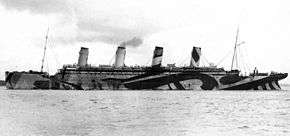
Naval service
Following Olympic's return to Britain, the White Star Line intended to lay her up in Belfast until the war was over, but in May 1915 she was requisitioned by the Admiralty, to be used as a troop transport, along with the Cunard liners Mauretania and Aquitania. The Admiralty had initially been reluctant to use large ocean liners as troop transports because of their vulnerability to enemy attack, however a shortage of ships gave them little choice. At the same time, Olympic's other sister ship Britannic, which had not yet been completed, was requisitioned as a hospital ship. In that role she would strike a mine and sink the following year.[55]
Stripped of her peacetime fittings and now armed with 12-pounders and 4.7-inch guns, Olympic was converted to a troopship, with the capacity to transport up to 6,000 troops. On 24 September 1915 the newly designated HMT (Hired Military Transport) 2810, now under the command of Bertram Fox Hayes left Liverpool carrying 6,000 soldiers to Mudros, Greece for the Gallipoli Campaign. On 1 October lifeboats from the French ship Provincia which had been sunk by a U-boat that morning off Cape Matapan were sighted and 34 survivors rescued by Olympic. Hayes was criticised for this action by the British Admiralty, who accused him of putting the ship in danger by stopping it in waters where enemy U-boats were active. The ship's speed was considered to be its best defence against U-boat attack, and such a large ship stopped would have made an unmissable target. However the French Vice-Admiral Louis Dartige du Fournet took a different view, and awarded Hayes with the Gold Medal of Honour. Olympic made several more trooping journeys to the Mediterranean until early 1916, when the Gallipoli Campaign was abandoned.[56]
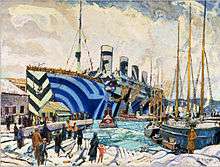
In 1916, considerations were made to use Olympic to transport troops to India via the Cape of Good Hope. However, on investigation it was decided that the ship was unsuitable for this role, because the coal bunkers, which had been designed for transatlantic runs, lacked the capacity for such a long journey at a reasonable speed.[57] Instead, from 1916 to 1917, Olympic was chartered by the Canadian Government to transport troops from Halifax, Nova Scotia to Britain.[58] In 1917 she gained 6-inch guns and was painted with a "dazzle" camouflage scheme to make it more difficult for observers to estimate her speed and heading. Her dazzle colours were brown, dark blue, light blue, and white. Her many visits to Halifax Harbour carrying Canadian troops safely overseas, and back home after the war at Pier 2, made her a favourite symbol in the City of Halifax. Noted Group of Seven artist Arthur Lismer made several paintings of her in Halifax. A large dance hall, "Olympic Gardens" was also named in her honour. After the United States declared war on Germany in 1917, Olympic also transported thousands of U.S. troops to Britain.[59]
In the early hours of 12 May 1918, while en route for France with US troops under the command of Captain Hayes, Olympic sighted a surfaced U-boat 500 m (1,600 ft) ahead.[60] Olympic's gunners opened fire at once, and the ship turned to ram the submarine, which immediately crash dived to 30 m (98 ft) and turned to a parallel course. Almost immediately afterwards Olympic struck the submarine just aft of her conning tower with her port propeller slicing through U-103's pressure hull. The crew of U-103 blew her ballast tanks, scuttled and abandoned the submarine.Olympic did not stop to pick up survivors, but continued on to Cherbourg. Meanwhile, the USS Davis had sighted a distress flare and picked up 31 survivors from U-103. Olympic returned to Southampton with at least two hull plates dented and her prow twisted to one side, but not breached.[61]
It was subsequently discovered that U-103 had been preparing to torpedo Olympic when she was sighted, but the crew were not able to flood the two stern torpedo tubes.[62] For his service, Captain Hayes was awarded the DSO.[63] Some American soldiers on board paid for a plaque to be placed in one of Olympic's lounges to commemorate the event, it read:
This tablet presented by the 59th Regiment United States Infantry commemorates the sinking of the German submarine U103 by the Olympic on May 12th 1918 in latitude 49 degrees 16 minutes north longitude 4 degrees 51 minutes west on the voyage from New York to Southampton with American troops...[64]
.jpg)
During the war, Olympic is reported to have carried up to 201,000 troops and other personnel, burning 347,000 tons of coal and travelling about 184,000 miles.[65] Her impressive war service earned her the nickname Old Reliable.[66] Her captain was knighted in 1919 for "valuable services in connection with the transport of troops".[67]
Post-war
In August 1919 Olympic returned to Belfast for restoration to civilian service. Her interior was modernised and her boilers were converted to burn oil rather than coal as it lowered the refuelling time from days to hours, it also gave a steadier engine R.P.M and allowed the engine room personnel to be reduced from 350 to 60 people.[68] During the conversion work and drydocking, a dent with a crack at the centre was discovered below her waterline which was later concluded to have been caused by a torpedo that had failed to detonate.[69]
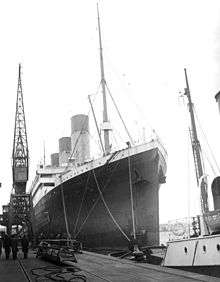
Olympic emerged from her refit with an increased tonnage of 46,439, allowing her to retain her claim to the title of largest British built liner afloat, although the Cunard Line's Aquitania was slightly longer. In 1920 she returned to passenger service, on one voyage that year carrying 2,249 passengers.[70] Olympic transported a record 38,000 passengers during 1921, which proved to be the peak year of her career. From 1922 she was joined for an express service by Majestic and Homeric, two former German liners which had been ceded to Britain as war reparations, operating successfully until the Great Depression reduced demand after 1930.[71]
During the 1920s, Olympic remained a popular and fashionable ship, and often attracted the rich and famous of the day; Charlie Chaplin, Mary Pickford and Douglas Fairbanks, and Prince Edward, then Prince of Wales, were among the celebrities that she carried.[72] Prince Edward and Captain Howarth were filmed on the bridge of the Olympic for Pathé News.[73] According to his autobiography,[74] Cary Grant, then Archibald Leach, first set sail to New York on the Olympic on 21 July 1920 on the same voyage on which Douglas Fairbanks and Mary Pickford were celebrating their honeymoon. One of the attractions of Olympic was the fact that she was nearly identical to the Titanic, and many passengers sailed on Olympic as a way of vicariously experiencing the voyage of Olympic's sister ship.[75]
On 22 March 1924, Olympic was involved in another collision with a ship, this time at New York. As Olympic was reversing from her berth at New York harbour, her stern collided with the smaller liner Fort St George, which had crossed into her path. The collision caused extensive damage to the smaller ship. At first it appeared that Olympic had sustained only minor damage, but it was later revealed that her sternpost had been fractured, necessitating the replacement of her entire stern frame.[76]
Changes in immigration laws in the United States in the 1920s greatly restricted the number of immigrants allowed to enter. This led to a major reduction in the immigrant trade for the shipping lines, forcing them to cater to the tourist trade to survive.[3] At the turn of 1927–28, Olympic was converted to carry tourist third cabin passengers as well as first, second and third class.[77] Tourist third cabin was an attempt to attract travellers who desired comfort without the accompanying high ticket price. New public rooms were constructed for this class, although tourist third cabin and second class would merge to become 'tourist' by late 1931.
A year later, Olympic's first class cabins were again improved by adding more bathrooms, a dance floor was fitted in the enlarged first class dining saloon, and a number of new suites with private facilities were installed forward on B-deck.[78] More improvements would follow in a later refit, but 1929 saw Olympic's best average passenger lists since 1925.
On 18 November 1929, as Olympic was travelling westbound near to Titanic's last known position, the ship suddenly started to vibrate violently, and the vibrations continued for two minutes. It was later determined that this had been caused by the 1929 Grand Banks earthquake.[79]
Last years
The shipping trade was badly affected by the Great Depression. Until 1930 there had generally been around one million passengers a year on the transatlantic route, but by 1934 this had dropped by more than half. Furthermore, by the early 1930s, increased competition emerged, in the form of a new generation of larger and faster liners such as Germany's SS Bremen and SS Europa, Italy's SS Rex and France's SS Île de France, and the remaining passengers tended to prefer the more up-to-date ships. Olympic had averaged around 1,000 passengers per journey until 1930, but this declined by more than half by 1932.[80]
Olympic's running mate Homeric was withdrawn from the transatlantic route as early as 1932, leaving only Olympic and Majestic maintaining White Star Line's Southampton-New York service, although this was occasionally augmented during the summer months by either the MV Britannic or MV Georgic. [81] During slack periods in the summer, Olympic and fleet mate Majestic were employed in summer recreational cruises from New York to Pier 21 in Halifax, Nova Scotia.[82]
At the end of 1932, with passenger traffic in decline, Olympic went for an overhaul and refit that took four months. She returned to service in March 1933 described by her owners as "looking like new." Her engines were performing at their best and she repeatedly recorded speeds in excess of 23 knots, despite averaging less than that in regular transatlantic service. Passenger capacities were given as 618 first class, 447 tourist class and only 382 third class after the decline of the immigrant trade.[83]
Despite this, during 1933 and 1934, Olympic ran at a net operating loss for the first time. 1933 was Olympic's worst year of business – carrying just over 9,000 passengers in total.[84] Passenger numbers rose slightly in 1934, but many crossings still lost money.[81]

Lightship collision
In 1934, Olympic again struck a ship. The approaches to New York were marked by lightships and Olympic, like other liners, had been known to pass close by these vessels. On 15 May 1934, Olympic, inbound in heavy fog, was homing in on the radio beacon of Nantucket Lightship LV-117.[85] Now under the command of Captain John Binks, the ship failed to turn in time and sliced through the smaller vessel, which broke apart and sank.[86] Four of the lightship's crew went down with the vessel and seven were rescued, of whom three died of their injuries – thus there were seven fatalities out of a crew of eleven.[87] The lightship's surviving crew and the Olympic's captain were interviewed soon after reaching shore. One crewman said it all happened so quickly that they didn't know how it happened. The captain was very sorry it happened but said the Olympic reacted very quickly lowering boats to rescue the crew, which was confirmed by an injured crewman.[88]
Retirement

In 1934, the White Star Line merged with the Cunard Line at the instigation of the British government, to form Cunard White Star.[89] This merger allowed funds to be granted for the completion of the future RMS Queen Mary and RMS Queen Elizabeth. When completed, these two new ships would handle Cunard White Star's express service, and so their fleet of older liners became redundant and were gradually retired.
Olympic was withdrawn from the transatlantic service, and left New York for the last time on 5 April 1935, returning to Britain to be laid up. Her new owners considered using her for summer cruises for a short while, but this idea was abandoned and she was put up for sale. Among the potential buyers was a syndicate who proposed to turn her into a floating hotel off the south coast of France, but this came to nothing.[90] After being laid up for five months alongside her former rival Mauretania, she was sold to Sir John Jarvis – Member of Parliament for £97,500, to be partially demolished at Jarrow to provide work for the depressed region.[91] Her superstructure was demolished in 1936, and in 1937, Olympic's hull was towed to Inverkeithing to Thos W Ward's yard for final demolition.[92]
By the time of her retirement, Olympic had completed 257 round trips across the Atlantic, transporting 430,000 passengers on her commercial voyages, travelling 1.8 million miles.[90][93]
Olympic artefacts
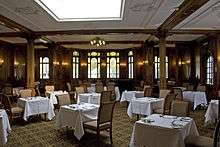

The Olympic's fittings were auctioned off immediately before she was scrapped; the fittings of the first-class lounge and part of the aft grand staircase can be found in the White Swan Hotel, in Alnwick, Northumberland, England. The rest of her fittings found homes in scattered places throughout Great Britain.[94] One suite at Sparth House Hotel, Clayton-le-Moors, Lancashire has the original furniture from one of the state rooms, including light fitting, sink, wardrobes and fireplace.
In 2000, Celebrity Cruises purchased some of Olympic's original wooden panels to create the RMS Olympic restaurant on board their new cruise ship, Millennium. According to the cruise line, this panelling had lined Olympic's à la carte restaurant.[94]
The clock depicting "Honour and Glory Crowning Time" from Olympic's grand staircase is on display at Southampton's SeaCity Museum.[95][96]
Official number and code letters
Official numbers are issued by individual flag states. They should not be confused with IMO ship identification numbers. Olympic had the UK Official Number 131345 and used the code letters HSRP.[97]
Popular culture
In London Weekend Television's Thomas and Sarah (1978–79), episode 2 "The Silver Ghost", a poster of the Olympic is prominently featured with just the lettering 'S.S. Olympic'. Later as the episode progresses we see the full poster showing the ship but the ship featured is the SS Leviathan in her 1920s United States Lines livery. Thomas and Sarah was a spin-off of the classic Upstairs, Downstairs in which the characters of Thomas and Sarah were a part of the household and which feature the Titanic in a couple of prominent episodes.
See also
- SS Nomadic – surviving tender to Olympic
References
- ↑ "Mark Chirnside's Reception Room: Olympic, Titanic & Britannic: Olympic Interview, January 2005". Markchirnside.co.uk. Retrieved 16 July 2009.
- ↑ Chirnside, Mark, RMS Olympic Specification File (November 2007)
- 1 2 3 4 5 6 7 8 "TGOL – Olympic". thegreatoceanliners.com.
- 1 2 Chirnside 2004, p. 319.
- ↑ Beveridge & Hall 2011, p. 27.
- ↑ Bartlett 2011, p. 26.
- 1 2 Bartlett 2011, p. 25.
- ↑ Hutchings & de Kerbrech 2011, p. 12.
- ↑ Hutchings & de Kerbrech 2011, p. 14.
- ↑ McCluskie 1998, p. 20.
- ↑ Eaton & Haas 1995, p. 55.
- ↑ Eaton & Haas 1995, p. 56.
- ↑ Oceanic II – thegreatoceanliners.com
- 1 2 "RMS Olympic – The Old Reliable". titanicandco.com.
- ↑ (French) Les escaliers de 1 Classe, le Site du Titanic. Retrieved 30 July 2009
- ↑ (French) La Vie à bord du Titanic, le Site du Titanic. Retrieved 30 July 2009
- ↑ (French) Les Bains Turcs et la Piscine, le Site du Titanic. Retrieved 30 July 2009
- ↑ (French) Le Gymnase, le Site du Titanic. Retrieved 30 July 2009
- 1 2 New York Times – Olympic Like A City – 18 June 1911 encyclopedia-titanica.org
- ↑ Chirnside 2004, p. 28.
- ↑ "RMS Mauretania".
- ↑ Chirnside, Mark (2011). The 'Olympic' Class Ships. The History Press. p. 142. ISBN 978-0-7524-5895-3.
- ↑ "RMS Olympic". whitestarhistory.com.
- ↑ "Southampton in 1912". Southampton City Council. Retrieved 1 April 2012.
- ↑ Olympic and Titanic: Maiden Voyage Mysteries, by Mark Chirnside and Sam Halpern – encyclopaedia-titanica. org
- ↑ Chirnside 2004, p. 45.
- ↑ "ANDREWS, Mr Thomas – Titanic First Class Passenger Biography". titanic-titanic.com.
- ↑ Chirnside, Mark (2011). The 'Olympic' Class Ships. The History Press. p. 59. ISBN 978-0-7524-5895-3.
- 1 2 3 Marriott, Leo (1997). TITANIC. PRC Publishing Ltd. ISBN 1-85648-433-5.
- ↑ "Olympic". tripod.com.
- ↑ "Titanic's unsinkable stoker" BBC News 30 March 2012
- ↑ Beveridge, p. 76
- ↑ Bonner, Kit; Carolyn Bonner (2003). Great Ship Disasters. MBI Publishing Company. pp. 33–34. ISBN 978-0-7603-1336-7.
- ↑ "Why A Huge Liner Runs Amuck", February 1932, Popular Mechanics. Google Books. Retrieved 29 February 2012.
- ↑ "Classic Liners and Cruise Ships – RMS Titanic". Cruiseserver.net. Retrieved 16 July 2009.
- ↑ Titanic Inquiry Project (2012, p. 2)
- 1 2 3 4 Titanic Inquiry Project (2012, p. 1)
- ↑ Chirnside 2004, p. 76.
- ↑ "TIP – United States Senate Inquiry – Day 18". titanicinquiry.org.
- 1 2 Chirnside 2004, p. 83.
- 1 2 Chirnside 2004, p. 78.
- ↑ "FIREMEN STRIKE; OLYMPIC HELD; Part of Crew Leave Vessel as She Is About to Sail from Southampton with 1,400 Passengers." (PDF). New York Times. 25 April 1912.
- ↑ "OLYMPIC STRIKERS MAKE NEW DEMAND; Now Satisfied with the Collapsible Boats, but Want Non-Strikers Dismissed." (PDF). New York Times. 26 April 1912.
- ↑ "FREE OLYMPIC MUTINEERS.; Magistrates Find Charges Proved, but Forego Jailing or Fining Seamen." (PDF). New York Times. 5 May 1912.
- ↑ Chirnside 2004, p. 84.
- ↑ MODIFICATIONS TO OLYMPIC FOLLOWING THE TITANIC DISASTER – www.titanicology.com
- ↑ Chirnside 2004, pp. 84–85.
- ↑ Miller, William H. (2001). Picture History of British Ocean Liners, 1900 to the Present. Dover Publications. ISBN 978-0-486-41532-1.
- ↑ Chirnside 2004, p. 87.
- 1 2 Chirnside, Mark (2011). The 'Olympic' Class Ships. The History Press. pp. 88–89. ISBN 978-0-7524-5895-3.
- ↑ Chirnside 2004, p. 88.
- ↑ Chirnside 2004, pp. 89–90.
- ↑ Chirnside 2004, p. 90.
- ↑ Hessen, Robert. Steel Titan: The Life of Charles M. Schwab. Retrieved 26 April 2012.
- ↑ Chirnside, Mark (2011). The 'Olympic' Class Ships. The History Press. p. 94. ISBN 978-0-7524-5895-3.
- ↑ Chirnside, Mark (2011). The 'Olympic' Class Ships. The History Press. p. 96. ISBN 978-0-7524-5895-3.
- ↑ Chirnside, Mark (2011). The 'Olympic' Class Ships. The History Press. p. 98. ISBN 978-0-7524-5895-3.
- ↑ Chirnside 2004, p. 98.
- ↑ Chirnside 2004, p. 100.
- ↑ Chirnside 2004, p. 101.
- ↑ Gibson, Richard Henry; Prendergast, Maurice (1931). The German submarine war, 1914–1918. Constable. p. 304. ISBN 978-1-59114-314-7. Retrieved 3 May 2011.
- ↑ McCartney, Innes; Jak Mallmann-Showell (2002). Lost Patrols: Submarine Wrecks of the English Channel. Periscope Publishing Ltd. p. 36. ISBN 978-1-904381-04-4.
- ↑ "Page 7302 – Supplement 30756, 18 June 1918 – London Gazette – The Gazette". thegazette.co.uk.
- ↑ Chirnside, Mark (2011). The 'Olympic' Class Ships. The History Press. p. 101. ISBN 978-0-7524-5895-3.
- ↑ 6 November 2008 1:30 pm by Kelly Wilson (6 November 2008). "RMS Olympic". Members.aol.com. Retrieved 16 July 2009.
- ↑ Chirnside 2004, p. 99.
- ↑ "Page 11575 – Supplement 31553, 12 September 1919 – London Gazette – The Gazette". thegazette.co.uk.
- ↑ Chirnside 2004, p. 103.
- ↑ Olympic II titanic-titanic.com
- ↑ Chirnside 2004, p. 106.
- ↑ Chirnside, Mark (2011). The 'Olympic' Class Ships. The History Press. p. 115. ISBN 978-0-7524-5895-3.
- ↑ Chirnside, Mark (2011). The 'Olympic' Class Ships. The History Press. pp. 112–113. ISBN 978-0-7524-5895-3.
- ↑ "I'm Glad To Be Home". British Pathé. 16 February 1925. Retrieved 10 September 2015.
- ↑ Archie Leach, Ladies Home Journal, January/February 1963 (Part 1), March 1963 (Part 2), April 1963 (Part 3)
- ↑ Wade, Wyn Craig, "The Titanic: End of a Dream," Penguin Books, 1986 ISBN 978-0-14-016691-0
- ↑ Chirnside, Mark (2011). The 'Olympic' Class Ships. The History Press. p. 117. ISBN 978-0-7524-5895-3.
- ↑ Chirnside 2004, p. 120.
- ↑ Chirnside 2004, p. 119.
- ↑ Chirnside, Mark (2011). The 'Olympic' Class Ships. The History Press. p. 120. ISBN 978-0-7524-5895-3.
- ↑ Chirnside 2004, pp. 121–131.
- 1 2 Chirnside 2004, p. 135.
- ↑ "SS Bismark/RMS Majestic", Monsters of the Sea: The Great Ocean Liners of Time
- ↑ Chirnside 2004, p. 127.
- ↑ Chirnside, Mark (2011). The 'Olympic' Class Ships. The History Press. p. 357. ISBN 978-0-7524-5895-3.
- ↑ "History of U.S. Lightships". Palletmastersworkshop.com. Retrieved 16 July 2009.
- ↑ Doherty, John (3 September 2004). "Lightship bell raised from ocean's depths". SouthCoastToday.com. Fairhaven. Archived from the original on 10 October 2004. Retrieved 10 September 2015.
- ↑ "de beste bron van informatie over night beacon. Deze website is te koop!". nightbeacon.com. Retrieved 29 February 2012.
- ↑ ""Olympic" Rams Lightship". British Pathé. 28 May 1934. Retrieved 10 September 2015.
- ↑ "White Star Line Archives – 1931". Chriscunard.com. Archived from the original on 27 June 2009. Retrieved 16 July 2009.
- 1 2 Chirnside, Mark (2011). The 'Olympic' Class Ships. The History Press. pp. 136–140. ISBN 978-0-7524-5895-3.
- ↑ Chirnside 2004, p. 137.
- ↑ Chirnside 2004, p. 140.
- ↑ RMS Olympic: Another Premature Death? – Mark Chirnside – encyclopaedia-titanica.org
- 1 2 "Olympic Today". atlanticliners.com.
- ↑ "RMS Olympic BL24990_002". Englishheritageimages.com. Retrieved 29 February 2012.
- ↑ "Collections and Exhibitions". Southampton City Council. Archived from the original on 26 September 2014. Retrieved 10 September 2015.
- ↑ "Lloyd's Register, Navires a Vapeur et a Moteurs" (PDF). Plimsoll Ship Data. Retrieved 28 February 2012.
Further reading
- Beveridge, Bruce; Steve Hall (2004). Olympic & Titanic. Buy Books. ISBN 978-0-7414-1949-1.
- Chirnside, Mark (2015). RMS Olympic: Titanic's Sister. Stroud, Gloucestershire: The History Press. ISBN 9780752491516.
- Hawley, Brian (2012). RMS Olympic. Stroud, Gloucestershire: Amberley Publishing. ISBN 9781445600932.
- Layton, J. Kent, Atlantic Liners: A Trio of Trios
- Talbot, Frederick A. (June 1911). "The Coming of The "Olympic": A Ship That Has Caused Shipyards And Piers To Be Enlarged And Harbors To Be Dredged". The World's Work: A History of Our Time. XXII: 14507–14515. Retrieved 10 July 2009.
External links
| Wikimedia Commons has media related to Olympic (ship, 1910). |
| Wikimedia Commons has media related to White Swan Hotel, Alnwick. |
- Titanic Research & Modelling Association, for Olympic-Class Research
- RMS Olympic, the Original Ship of Dreams: a site dedicated to the ship's surviving relics
- Olympic Home at Atlantic Liners
- "RMS Olympic; Old Reliable". Archived from the original on 20 November 2007. Retrieved 17 April 2012.
- Encyclopedia Titanica: RMS Olympic
- Olympic on Titanic-Titanic.com
- The RMS Olympic Restaurant on the Celebrity Millennium (Virtual Tour of ship's Plaza Deck shows panoramic view).
- Olympic's Fittings at White Swan Hotel, Alnwick, England
- Maritimequest RMS Olympic Photo Gallery
- "Lostliners: RMS Olympic". Archived from the original on 29 January 2008. Retrieved 17 April 2012.
- "White Star Line RMS Olympic the Ship Magnificent". Archived from the original on 9 November 2007. Retrieved 17 April 2012.
- Lego RMS Olympic
- "Olympic". Chris' Cunard Page. Retrieved 16 February 2010.
- White Star Line History Website, Olympic's owners.
- Images of RMS Olympic at the English Heritage Archive
- Article from Encyclopedia Titanica describing a Titanic themed meal in a house with fittings from the Olympic's restaurant
- Pathé News gallery on the Olympic class